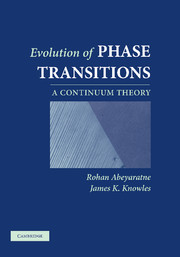Book contents
- Frontmatter
- Contents
- Preface
- Part I Introduction
- Part II Purely Mechanical Theory
- Part III Thermomechanical Theory
- Part IV One-Dimensional Thermoelastic Theory and Problems
- 9 Models for Two-Phase Thermoelastic Materials in One Dimension
- 10 Quasistatic Hysteresis in Two-Phase Thermoelastic Tensile Bars
- 11 Dynamics of Phase Transitions in Uniaxially Strained Thermoelastic Solids
- Part V Higher Dimensional Problems
- Author Index
- Subject Index
11 - Dynamics of Phase Transitions in Uniaxially Strained Thermoelastic Solids
Published online by Cambridge University Press: 12 August 2009
- Frontmatter
- Contents
- Preface
- Part I Introduction
- Part II Purely Mechanical Theory
- Part III Thermomechanical Theory
- Part IV One-Dimensional Thermoelastic Theory and Problems
- 9 Models for Two-Phase Thermoelastic Materials in One Dimension
- 10 Quasistatic Hysteresis in Two-Phase Thermoelastic Tensile Bars
- 11 Dynamics of Phase Transitions in Uniaxially Strained Thermoelastic Solids
- Part V Higher Dimensional Problems
- Author Index
- Subject Index
Summary
Introduction
In Chapter 4 we studied one-dimensional models of dynamic phase transitions in the purely mechanical theory of elastic materials. Our objective here is to extend the ideas of that chapter to the dynamics of two-phase thermoelastic materials. Much of the analysis will be directed to the materials of Mie–Grüneisen type introduced in Chapter 9, with special emphasis on the trilinear thermoelastic material. As in Chapter 4, we shall study an impact-induced phase transition that occurs in compression, rather than in tension; this will require some minor modifications of the details of the constitutive models presented in Chapter 9.
The subject of nonlinear wave propagation in solids has an enormous literature encompassing both experimental and theoretical work. For a sample of background references representing a variety of viewpoints in this field, the reader might consult the classic work on gas dynamics of Courant and Friedrichs [4], the extensive review article of Menikoff and Plohr [7], the discussion by Ahrens [2] of the experimental determination of the “equation of state” of condensed materials, the work of Swegle [9] on phase transitions in materials of geologic interest, and the theory of shock waves in thermoelastic materials presented by Dunn and Fosdick [5].
In the next section, we set out the basic field equations and jump conditions of the dynamical theory of thermoelasticity when the kinematics are those of uniaxial strain and the processes are adiabatic.
Information
- Type
- Chapter
- Information
- Evolution of Phase TransitionsA Continuum Theory, pp. 181 - 194Publisher: Cambridge University PressPrint publication year: 2006
